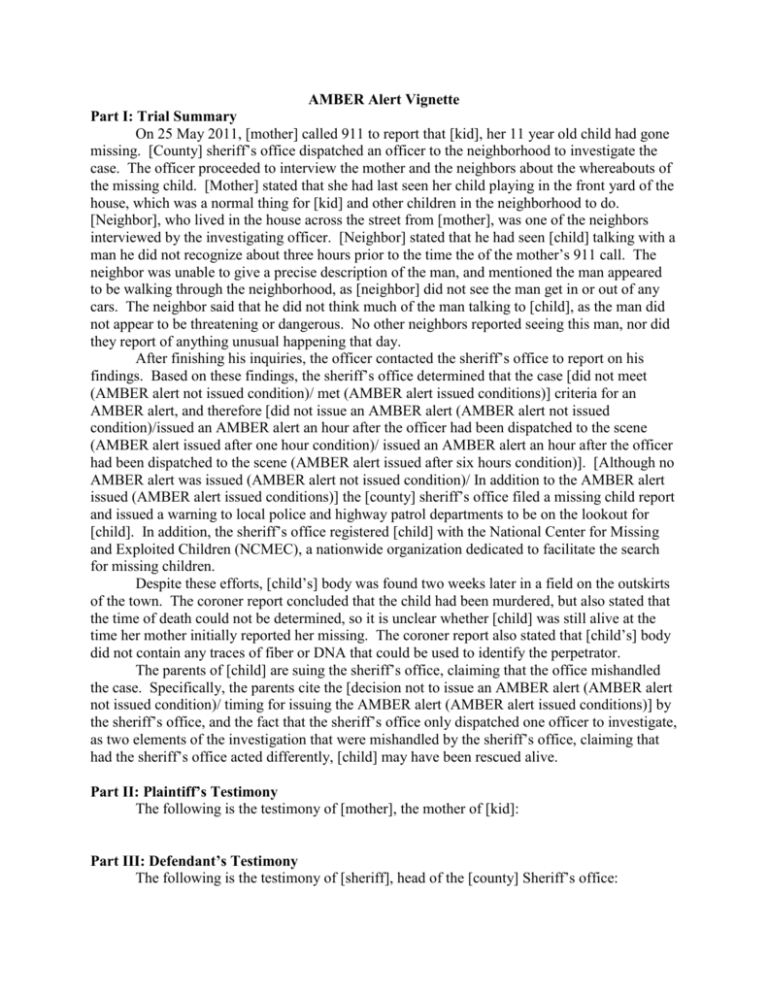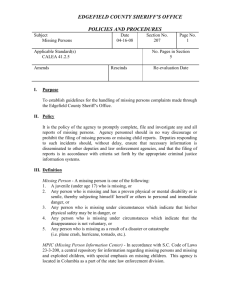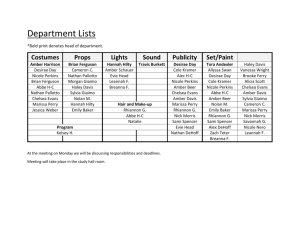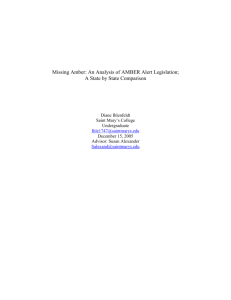AMBER Alert Vignette
advertisement

AMBER Alert Vignette Part I: Trial Summary On 25 May 2011, [mother] called 911 to report that [kid], her 11 year old child had gone missing. [County] sheriff’s office dispatched an officer to the neighborhood to investigate the case. The officer proceeded to interview the mother and the neighbors about the whereabouts of the missing child. [Mother] stated that she had last seen her child playing in the front yard of the house, which was a normal thing for [kid] and other children in the neighborhood to do. [Neighbor], who lived in the house across the street from [mother], was one of the neighbors interviewed by the investigating officer. [Neighbor] stated that he had seen [child] talking with a man he did not recognize about three hours prior to the time the of the mother’s 911 call. The neighbor was unable to give a precise description of the man, and mentioned the man appeared to be walking through the neighborhood, as [neighbor] did not see the man get in or out of any cars. The neighbor said that he did not think much of the man talking to [child], as the man did not appear to be threatening or dangerous. No other neighbors reported seeing this man, nor did they report of anything unusual happening that day. After finishing his inquiries, the officer contacted the sheriff’s office to report on his findings. Based on these findings, the sheriff’s office determined that the case [did not meet (AMBER alert not issued condition)/ met (AMBER alert issued conditions)] criteria for an AMBER alert, and therefore [did not issue an AMBER alert (AMBER alert not issued condition)/issued an AMBER alert an hour after the officer had been dispatched to the scene (AMBER alert issued after one hour condition)/ issued an AMBER alert an hour after the officer had been dispatched to the scene (AMBER alert issued after six hours condition)]. [Although no AMBER alert was issued (AMBER alert not issued condition)/ In addition to the AMBER alert issued (AMBER alert issued conditions)] the [county] sheriff’s office filed a missing child report and issued a warning to local police and highway patrol departments to be on the lookout for [child]. In addition, the sheriff’s office registered [child] with the National Center for Missing and Exploited Children (NCMEC), a nationwide organization dedicated to facilitate the search for missing children. Despite these efforts, [child’s] body was found two weeks later in a field on the outskirts of the town. The coroner report concluded that the child had been murdered, but also stated that the time of death could not be determined, so it is unclear whether [child] was still alive at the time her mother initially reported her missing. The coroner report also stated that [child’s] body did not contain any traces of fiber or DNA that could be used to identify the perpetrator. The parents of [child] are suing the sheriff’s office, claiming that the office mishandled the case. Specifically, the parents cite the [decision not to issue an AMBER alert (AMBER alert not issued condition)/ timing for issuing the AMBER alert (AMBER alert issued conditions)] by the sheriff’s office, and the fact that the sheriff’s office only dispatched one officer to investigate, as two elements of the investigation that were mishandled by the sheriff’s office, claiming that had the sheriff’s office acted differently, [child] may have been rescued alive. Part II: Plaintiff’s Testimony The following is the testimony of [mother], the mother of [kid]: Part III: Defendant’s Testimony The following is the testimony of [sheriff], head of the [county] Sheriff’s office: Part IV: Expert Witness’ Testimony The following is the testimony of [expert], an expert witness whose area of expertise is the effectiveness of AMBER alerts and the public’s reaction to AMBER alerts. [Expert] is a well known academic in the fields of social science and law, with over forty peer-reviewed articles and two books written on the subject of AMBER alerts. [Expert] has also worked as a consultant to help develop policies regarding the use of AMBER alerts and .











